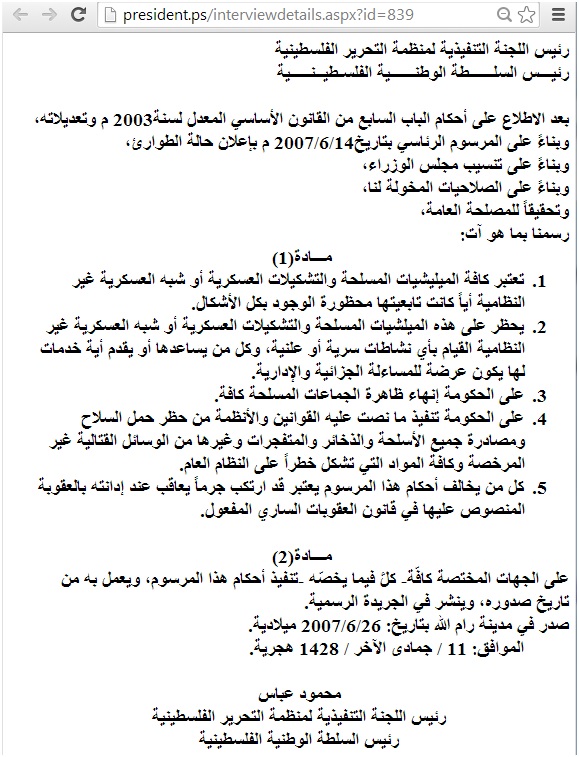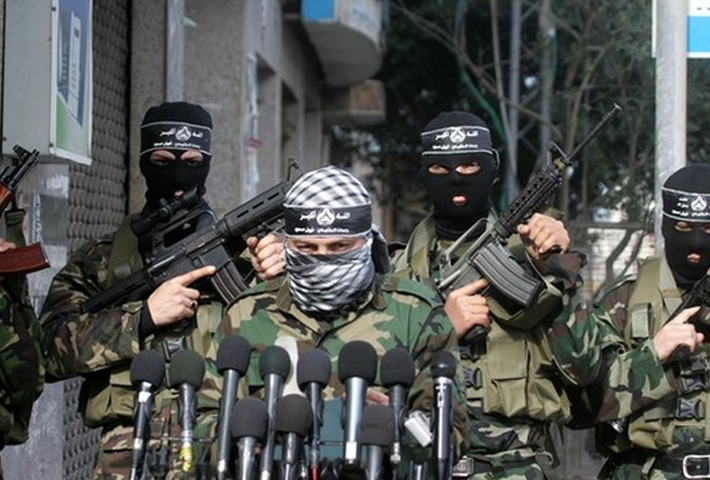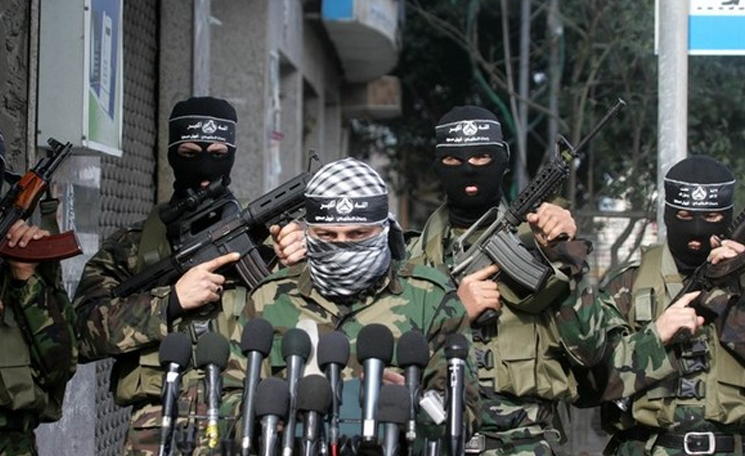- The official reestablishment of the Al-Aqsa Martyrs Brigades should serve as a red light regarding the validity of a future undertaking by Mahmoud Abbas to act against terror in the context of a political settlement.
- It should also constitute one of Israel’s important considerations when formulating its security requirements in the West Bank.
On July 26, 2007, Palestinian Authority chairman Mahmoud Abbas (Abu Mazen) announced the disarmament of “all the armed militias and irregular military or paramilitary groups” existing in the Palestinian Authority.1 This included the Al-Aqsa Martyrs Brigades, the military wing of the Fatah movement of which Abbas is the leader.
The then-Palestinian interior minister, Abd al-Raziq al-Yahyai,2 said that “the Al-Aqsa Brigades responded positively and responsibly to President Mahmoud Abbas’s decision as written in the published presidential decree on the dismantlement of all the militias and armed groups.”3
The disarmament of the Al-Aqsa Martyrs Brigades was carried out in the framework of the “Fugitives Agreement” between Israel and the Palestinian Authority, which took shape after Hamas’s armed takeover of the Gaza Strip in June and July 2007. In line with this agreement, Israel pardoned close to 200 Fatah fugitives in return for their signing a commitment to abandon the path of terror, depositing their weapons with the PA security mechanisms, and undergoing a trial period, first in PA prisons and afterward in Palestinian towns, during which they were forbidden to be involved in any way in weapons trade or terror.4
It was further stipulated that the PA security mechanisms would be responsible for implementing the agreement, and would absorb the pardoned men into their ranks. Each of the PA intelligence organizations adopted some of the men and was responsible for certifying that they had turned over their weapons. Subsequently the men were incarcerated in PA prisons under relatively comfortable conditions. After the incarceration, which lasted three to six months, the men received a “partial amnesty” that allowed them to move freely outside the prisons while still having to spend their nights in the headquarters of the security bodies. If they also fulfilled these terms, three months later the men received a “full amnesty” that allowed them to move freely within the West Bank without monitoring by the security organizations.5
The Re-emergence of Fatah’s Al-Aqsa Martyrs Brigades Today
More recently, in the midst of Operation Protective Edge in Gaza, which began on July 8, 2014, in response to the rocket fire on Israel, the headquarters of the Al-Aqsa Martyrs Brigades in the West Bank announced (July 22, 2014) an “open war against the Zionist enemy in all [possible] ways with [operational] surprises, in accordance with all the laws and international conventions that bestow on us [the Palestinian people] the right to armed struggle so as to remove this occupation from all the Palestinian land.”6
The announcement further stated that this would be a “war of attrition in which all options are open, including the activity of our military bands [the Al-Aqsa Martyrs Brigades] in the West Bank under the general command of the Al-Asifa Forces…. A war that will include many surprises, and that will create a balance of terror and lead to a campaign in the Zionist interior [a term for the territory of the sovereign state of Israel].”7
On August 16, the Al-Aqsa Martyrs Brigades published a summation of the terror attacks it had carried out in July and the first half of August in the West Bank and Jerusalem. Over 30 attacks were listed, of which the most significant were detailed as follows:8
July 22 – Firing toward Rehalim Junction south of Nablus, one soldier wounded
July 23 – Firing toward Gush Etzion Junction
July 23 – Firing toward an IDF force in the al-Aruv refugee camp
July 25 – Firing toward an IDF force near the village of Yatta in the Hebron district
July 25 – Firing toward the Kalandia checkpoint
July 25 – Firing toward the settlement of Beit El
July 25 – Shooting near the settlement of Itamar
July 30 – Firing toward an IDF force in the village of Qabalan in the Nablus district and wounding an IDF soldier
July 31 – Shooting near the Shavei Shomron checkpoint
August 4 – Shooting near the Hebrew University of Jerusalem and wounding of a soldier
August 4 – Firing toward an IDF force near the village of al-Khader in the Bethlehem district
August 4 – Firing toward the DCO liaison office in Beit Jalla
August 8 – Firing toward the settlement of Psagot in the Ramallah area
August 9 – Firing toward the IDF observation tower beside the al-Aruv refugee camp
August 9 – Firing toward an IDF force near the village of Jit in the Kalkilya district and wounding of a “Zionist”
August 9 – Firing toward an IDF force in the area of the Nur Shams refugee camp in the Tulkarem district
August 9 – Shooting in the al-Tur area south of Nablus
August 10 – Firing toward the Gush Etzion Junction
August 14 – Firing toward a force in Tulkarem
The Main Implications of the Intelligence Picture
Thus the Al-Aqsa Martyrs Brigades, the military wing of the Fatah movement headed by Mahmoud Abbas, is officially returning to terror activity against Israel, attacking civilian and military targets in the West Bank while declaring an intention to carry out attacks within Israel as well. This opens an additional front with Israel as the chances of a third Intifada grow.
It is not known whether Abbas has given his consent to the reestablishment of the Fatah military wing and to its official return to terror activity.
Although the organizing of the Al-Aqsa Martyrs Brigades and the taking of responsibility for the terror attacks are well evident to the Palestinian leadership, so far this leadership, with Abbas at the forefront, has not yet officially addressed the matter. If Abbas approved the decision then he is a partner to the terror policy; if not, then it indicates his weakness as a leader and negotiating partner capable of signing a political settlement with Israel based on compromise.
The official reestablishment of the Al-Aqsa Martyrs Brigades once again shows the real weight of the presidential decrees that Abbas issues, which often lack any real value in the Palestinian sphere and serve mainly as a smokescreen for achieving political goals. From Israel’s standpoint, this matter should serve as a red light regarding the validity of a future undertakings by Mahmoud Abbas to act against terror in the context of a political settlement, and should constitute one of Israel’s important considerations when formulating its security requirements in the West Bank.
Appendix: The 2007 Presidential Decree of Mahmoud Abbas on Dismantling the Armed Militias
Chairman of the Executive Committee of the PLO
President of the Palestinian National Authority
After consideration of the items in Chapter 7 of the Revised Basic Law of 2003 and its amendments, and in reference to the presidential decree of June 14, 2007, which declared a state of emergency, and based on the recommendation of the government, and based on the powers granted, and on behalf of serving the public interest, we decree as follows:
Item 1
1. The existence of any element of any of the armed militias and of the irregular military or paramilitary groups is prohibited without connection to their
2. It is forbidden for any armed militias or irregular military or paramilitary groups to conduct any covert or overt activity, and anyone who assists them or provides them with services will bear the criminal and administrative responsibility.
3. The government is required to put a complete end to the phenomenon of the armed groups.
4. The government must implement the provisions of the laws and regulations concerning the prohibition on carrying weapons and the confiscation of all weapons, ammunition, explosives, and other war materials that are not licensed and of all materials that constitute a danger to the public order.
5. Whoever violates the injunctions of this decree will be considered to have committed a crime for which the punishment will be in accordance with what is stipulated in the existing Law of Punishment.
Item 2
All the relevant actors, each in its own domains, must implement the injunctions of this decree and act in accordance with it from the date of its issuance and it will be published in the records.
Published in the city of Ramallah on the date of June 26, 2007, which accords with the 11th of the month of Jumada 1428 of the Hijra.
Mahmoud Abbas
Chairman of the Executive Committee of the PLO
President of the Palestinian National Authority
Source: http://president.ps/interviewdetails.aspx?id=839

* * *
Notes
1 http://president.ps/interviewdetails.aspx?id=839
2 An-Nahar, Lebanon, December 30, 2007
3 http://www.annaharkw.com/Annahar/ArticlePrint.aspx?id=40404
4 http://news.walla.co.il/?w=/2687/1507410
5 http://news.walla.co.il/?w=/2687/1507410
6 https://www.youtube.com/watch?v=a3skz-ZlCM0
7 https://www.youtube.com/watch?v=a3skz-ZlCM0
8 https://www.facebook.com/1387945651452238/photos/a.1387949328118537.1073741828.
1387945651452238/1412730608973742/?type=1
– See more at: http://jcpa.org/al-aqsa-martyrs-brigades-military-wing-fatah/#sthash.Nj9wiemE.dpuf










